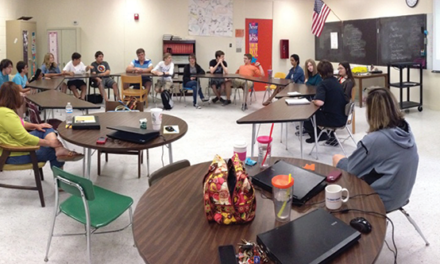The study of history may challenge students’ preconceptions about their nation, but that doesn’t mean we should shy away from hard truths.
You may have seen similar images: A crowd of people wielding torches surrounding a statue, a burning cross, or a hanging body. Until last summer, many of us saw these kinds of images as relics of the past or images of faraway places.
But this image is neither foreign nor from the past. In August 2017, in Charlottesville, Va., a group of Americans, mostly men, most (if not all) White, were photographed wielding torches and chanting racist and neo-Nazi slogans (“You will not replace us, Jews will not replace us”) as they circled a statue of Thomas Jefferson, founder of the University of Virginia and a slave owner. They gathered in response to the threatened removal of Confederate statues across the South, including Virginia. In this case, the statue at the center of the controversy was of General Robert E. Lee, who led the Confederate armies in the U.S. Civil War.
The following morning, two protesting groups gathered in and around Emancipation Park, once called Lee Park, the location of the Robert E. Lee statue. A few months earlier, the Charlottesville City Council had voted to change the park’s name and remove the statue. One group, which included the torch wielders of the night before, was protesting to keep the statue in place. For them, efforts to remove the monuments reinforced deep anxieties about the diminishing status of whiteness and maleness in America. For the counterprotesters, the monuments symbolize White supremacy and a rejection of the core American belief that all people are created equal.
Both groups interpreted these historical monuments through the politics of the present. Many of those who argued for keeping Confederate statues claimed to do so based on an “outpouring of grief and remembrance for the hundreds of thousands who had died in the war [when] nearly a quarter of Southern white men in their twenties were killed or died from disease” (Davidson, 2017). Yet those who argue for their removal noted that many were erected not in the aftermath of the Civil War but in the first half of the 20th century in a symbolic effort to reassert White dominance amid challenges to racist policies and practices. Tragically, but not for the first time in history, one of those defending the monuments was willing to kill for his beliefs; he ran over a counterprotester with his car, killing her and injuring 19 others.
We want young people to engage with difficult histories without reinforcing ethnic, religious, and cultural divisions on the one hand, or undermining social cohesion on the other.
All modern nation-states have periods of what we call difficult history, periods that reverberate in the present and surface fundamental disagreements over who we are and what values we hold. Like the Civil War and its aftermath, these histories complicate the kind of positive patriotism that schools traditionally seek to develop. Educators are sometimes reluctant to tackle these difficult histories in the classroom — and when they do, their instruction may be inadequate. See, for example, the Southern Poverty Law Center’s recent research into how schools, standards, and textbooks address American slavery (Shuster, 2018).
Our goal is to advance a new agenda for research and practice in history education. We believe that it is possible and essential to teach controversial historical events and topics in the classroom. The December 2017/January 2018 issue of Kappan shows how teachers are successfully taking on this work. We hope to continue the conversation by providing a framework for thinking about why certain histories are difficult.
Difficult histories in education
Difficult histories present a challenge to parents and students, as well as teachers and administrators, in part because the organizing purpose of history as a school subject has been to create citizens, not just teach about the past for its own sake.
Though all nations have difficult histories, the challenge of addressing them in and outside the classroom is relatively recent. When modern history emerged as a school subject in the late 19th century, it was seen as part of the broader nation-building efforts of the time, emphasizing the triumphant narratives of the nation-state (Ramirez, 2012). According to historian David Thelen (1998), the modern practice of history was designed “to invent narratives and persuade peoples to interpret their personal experiences within national terms” (p. 373). More than any other subject, history promised a shared vision of a cohesive national past for generations of citizens. This kind of history “served to provide stories that [linked] individuals to the nation — to make the nation seem a logical or desirable or inevitable fulfillment of experiences for diverse individuals” (Thelen, 1998, p. 397).
Yet the events of the 20th century — world wars, genocide, and other mass violence, imperialism and the lingering effects of colonialism, along with deep intellectual shifts within the areas of history and the social sciences — gradually diminished the appeal of the nation-state as the primary focus of historical narratives and undermined the kind of patriotic history that schools sought to teach. Thelen (1998) argues that these developments eroded the “authority and identity of nations from both transnational and subnational directions” (p. 373). Transnationally, political and economic globalization and the development of a universal human rights discourse all diminished the authority of the nation-state as the sole guarantor of rights and liberties. Within the nation, the empowerment of women, as well as ethnic, religious, and other minorities, created room for alternative historical narratives that challenged national histories. In addition, the student movements that spread across Europe and the United States put social history, Black history, and women’s history at the forefront of people’s minds (Novick, 1988).
The dilemma of how best to represent national histories in this new context lies at the heart of the “history wars” fought in recent decades over the content of the history curriculum. These debates focus on which episodes to include and how they should be taught. A robust body of scholarship has analyzed these debates and the changes in the history curriculum over time and across national contexts. Missing from this scholarship, however, is a critical appraisal of the terms of the debates themselves: What is difficult history, and what makes it difficult in the first place? Why does one period provoke debate and controversy, while another does not?
Education scholars have proposed a number of related terms to describe these histories, such as sensitive pasts (Van Boxtel, Grever, & Klein, 2016), violent past (Cole, 2007), difficult knowledge (Britzman, 2000), and traumatic pasts (Psaltis, Carretero, & Cehajic-Clancy, 2017). This variety of terms and definitions, sometimes used interchangeably, indicates the complexity of the matter at hand.
Particular events are not “difficult” for all students in the same way, nor do they stay difficult in the same way over time.
Elizabeth A. Cole (2007) sees teaching the violent past as a form of reconciliation, a method of transitioning from war to presumably consolidated democracy. Examples include historical accountability movements in Latin America, truth commissions in Rwanda, and purges of government officials in Eastern Europe. However, difficult histories do not always involve a reconciliation of two opposing sides.
Deborah Britzman (2000) coined the term difficult knowledge to describe a psychoanalytic and trauma-based approach centered on questioning the self and the world, but such a term is of little practical use to teachers and education researchers who lack experience with psychoanalysis. The fact is, not all difficult histories induce melancholia or trauma, even if they make some people angry or resistant.
Carla Van Boxtel, Maria Grever, and Stephan Klein (2016) have used the term sensitive pasts and argued that students should take the perspective of historical actors and walk in their shoes, so to speak. Others caution that to encourage identification puts too much emphasis on our present perspective and risks trivializing what history has to teach about individual actions in difficult times (Wineburg, 2001).
Terrie Epstein and Carla L. Peck (2017) use the term difficult histories to denote the type of violence dominant groups enact on marginalized ones. They argue that any period of violence or bloodshed that causes emotional pain or trauma can be a difficult history. While some violent events are more difficult than others, and many histories in the curriculum, such as slavery, the Civil War, or the Holocaust, remain difficult to teach and learn, we have yet to encounter a framework for understanding why this is so. Thus, we believe there is value in defining the shared characteristics of difficult histories.
Defining difficult history
Schools tend to organize our study of history around periods of conflict. A glance through any U.S. history textbook covering the 19th century shows a steady succession of conflicts leading up to the Civil War. Similarly, the 20th century is dominated by war: The first and second World Wars (we often refer to the years between as the “inter-war years”) give way almost immediately to the Cold War and the Korean War. Conflict, along with its causes and consequences, provides the narrative structure for understanding our national past.
Although history instruction is frequently centered on conflict, not all violent history provokes the kinds of controversies and divisions that cause teachers to shy away from them or face challenges from inside and outside the classroom when teaching them. So what it is that makes difficult history difficult? We propose five criteria that can guide our thinking about how difficult histories are taught and learned:
1. Difficult histories are central to a nation’s history (whether or not they are so recognized by political elites). Periods or events that are parochial or only loosely connected to the national past may also be important, but they do not need to be integrated into the national storyline.
2. Difficult histories tend to refute broadly accepted versions of the past or stated national values. They are often dissonant with the narrative template that characterizes the overall memory of a national past (Wertsch, 2002), or they contradict such national values as tolerance or equality.
3. Difficult histories may connect with questions or problems facing us in the present. That is, they are relevant to the world around us.
4. Difficult histories often involve violence, usually collective or state sanctioned. Even when it is not state sanctioned, this type of violence may be committed by citizens of good social standing. Violence approved by the state or enacted by groups of supposedly upstanding citizens cannot be easily dismissed as aberrations or exceptions.
5. Partly as the result of the other four conditions, difficult histories create disequilibria that challenge existing historical understandings. To integrate these periods or events into an existing historical understanding may require people to change their assumptions or beliefs. Such a process comes at a cost, either individually, in adjusting our relationship to the nation and state, or collectively, in the national story we tell.
Consider the forced removal of Native Americans from Eastern states to reservations in the Midwest that occurred in the 19th century. This event is central to understanding the Westward expansion of U.S. territory (criterion 1), as well as such contemporary issues as poverty, land rights, and human rights related to Native American tribes (criterion 3). These events involved disturbing acts of collective and state-sanctioned violence (criterion 4) in ways that conflict with both stated national values and broadly accepted tenets of U.S. history (criterion 2). Finally, the policies of forced removal reveal that principles like equality under the law, universal human dignity, and personal liberty are historically contingent, and they require us to include racism as an explanatory variable in understanding past events (criterion 5).
Although these criteria offer us a way of determining which events might be difficult to teach and learn, particular events are not “difficult” for all students in the same way, nor do they stay difficult in the same way over time. The forced removal of Native Americans would hold different implications for a White, U.S.-born student from California and a Cherokee student in Oklahoma. An episode that might disorient a White student might simply confirm the narratives the Cherokee youth learned within her family or tribal community. Additionally, we should expect that the salience of this event would change over time. Discussing these events in 2018 might present new or different complexities — in the wake of recent activism over water rights at the Standing Rock Sioux Reservation — than they did just a few years ago.
What makes difficult history difficult is not how it confirms or complicates a particular student’s prior historical understanding but the degree to which it challenges or undermines the dominant societal narratives. Even if the Cherokee student finds this portrayal consistent with her historical understanding, she will grow up in a context where these experiences are sometimes drowned out by positive depictions of Westward expansion. And although contemporary national narratives and moral frames condemn the treatment of Native Americans, the legitimacy of U.S. territorial boundaries is rarely contested, thus creating dissonance for those who have been historically dispossessed.
A second example provides an East European context — the participation of Polish citizens in the murder or extortion of Jews during the Holocaust. The Poles were victims of the Nazis and the Soviets during World War II, and they put up the largest and most robust underground resistance during this time. Polish national identity thus hangs on a tale of heroes and victims during a period that eradicated one-third of Poland’s urban population (criterion 1). The revelation in the early 2000s that some Poles were also opportunistic oppressors who actively participated in the murder and plunder of their Jewish neighbors challenges, complicates, and ultimately rewrites what students believe about themselves and their national community (criterion 2). Though not state sanctioned, such violence was perpetrated by respectable men and women (criterion 4).
The historians (and teachers and artists) who exposed this shameful past have been threatened with prosecution by the Polish government under a new law that criminalizes mentioning Polish complicity in the crimes against Jews during the Holocaust (criteria 3 and 5), with some even receiving death threats (criterion 5). Still, physical traces of the past don’t automatically disappear (criteria 2 and 3). Fragments of Jewish gravestones used as building material are evident all over the country, with shadow imprints of mezuzah cases (small vessels that contain a sacred text placed on the doorframe of Jewish homes) over thousands of doorframes across Poland.
Cohesion among divisions
A coherent historical understanding would need to explain both Westward expansion and its inconsistency with core American ideals, to explain Polish citizens as both victims and willing collaborators. Of course, some might prefer to ignore or dispute a difficult history rather than modify their understanding of the past in order to accommodate it. Our framework does not assume that an altered historical understanding results from encountering these histories, only that the dissonance that a difficult history creates is significant enough that existing understandings prove insufficient. Even if one does attempt to make sense of the difficult history, there are a variety of coherent understandings that could result.
There is much at stake if difficult histories are left unexplored, as demonstrated by these and many more examples. This is a particular concern in post-conflict societies, but it is also important for pluralist democracies, including the United States. Recent events in Charlottesville offer a stark reminder of the consequences of leaving difficult histories underexamined or presented in partisan terms.
Yet teaching the difficult past in its full complexity carries risks as well. While addressing difficult histories can be fundamental to the development of historical understanding, they complicate one of the traditional functions of history education in modern nation-states — to communicate a shared understanding of a national past to new generations. Ultimately, we want young people to engage with difficult histories without reinforcing ethnic, religious, and cultural divisions on the one hand, or undermining social cohesion on the other. Our hope is that such robust engagement might enable our young people to grow up with the ability to approach the past on its own terms, and a willingness to revise their historical understandings as new information emerges.
References
Britzman, D.P. (2000). If the story cannot end: Deferred action, ambivalence, and difficult knowledge. In R.I. Simon, S. Rosenberg, & C. Eppert (Eds.), Between hope and despair: Pedagogy and the remembrance of historical trauma (pp. 27-57). Lanham, MD: Rowman & Littlefield.
Cole, E.A. (Ed.). (2007). Teaching the violent past: History education and reconciliation. Lanham, MD: Rowman & Littlefield.
Davidson, J.D. (2017, August 18). Why we should keep the Confederate monuments right where they are. The Federalist. http://thefederalist.com/2017/08/18/in-defense-of-the-monuments
Epstein, T. & Peck, C.L. (Eds.). (2017). Teaching and learning difficult histories in international contexts: A critical sociocultural approach. New York, NY: Routledge.
Novick, P. (1988). That noble dream: The ‘objectivity question’ and the American historical profession (Vol. 13). Cambridge, UK: Cambridge University Press.
Psaltis, C., Carretero, M., & Cehajic-Clancy, S. (Eds.). (2017). History education and conflict transformation: Social psychological theories, history teaching and reconciliation. Basingstoke, UK: Palgrave Macmillan.
Ramirez, F.O. (2012). The world society perspective: Concepts, assumptions, and strategies. Comparative Education, 48 (4), 423-439.
Shuster, K. (2018). Teaching hard history: American slavery. Montgomery, AL: Southern Poverty Law Center.
Thelen, D. (1998). Making history and making the United States. Journal of American Studies, 32 (3), 373-397.
Van Boxtel, C., Grever, M., & Klein, S. (2016). Sensitive pasts: Questioning heritage in education. New York, NY: Berghahn Books.
Wertsch, J. (2002). Voices of collective remembering. Cambridge, UK: Cambridge University Press.
Wineburg, S. (2001). Historical thinking and other unnatural acts: Charting the future of teaching the past. Philadelphia, PA: Temple University Press.
Originally published in May 2018 Phi Delta Kappan, 99 (8), 51-56. © 2018 Phi Delta Kappa International. All rights reserved.
ABOUT THE AUTHORS

Magdalena H. Gross
MAGDALENA H. GROSS is an assistant professor in the Department of Teaching and Learning, Policy, and Leadership in the College of Education at the University of Maryland, College Park. Next year, she will be a Senior Research Associate at Stanford University’s Center to Support Excellence in Teaching. She is an editor of the forthcoming Teaching and Learning Difficult Histories: Comparative Perspectives .

Luke Terra
LUKE TERRA is director of Community Engaged Learning and Research at the Haas Center for Public Service, Stanford University, Stanford, Calif. He is an editor of the forthcoming Teaching and Learning Difficult Histories: Comparative Perspectives .











